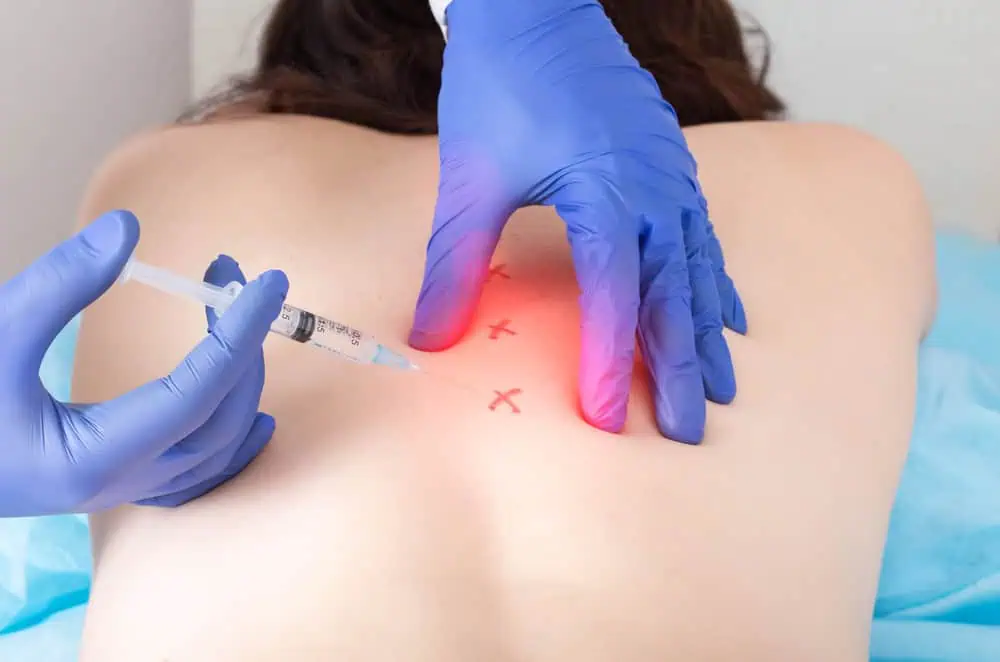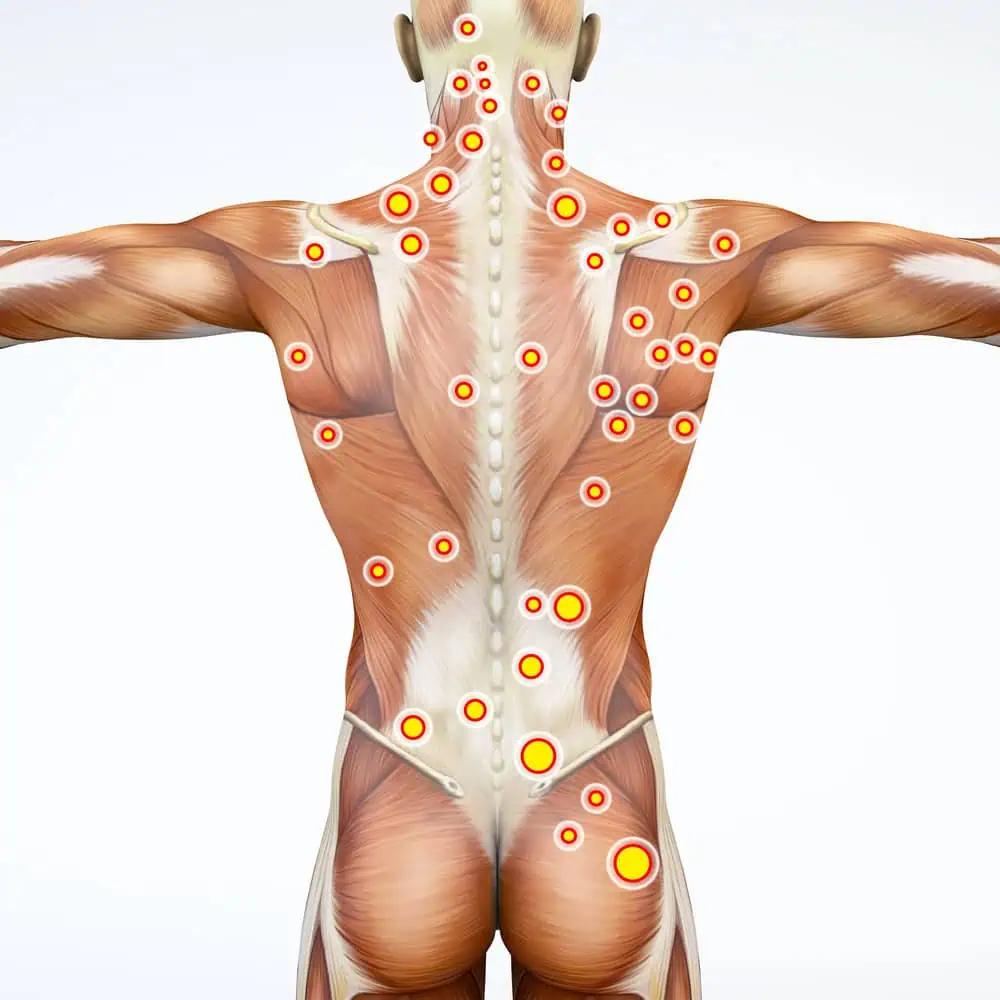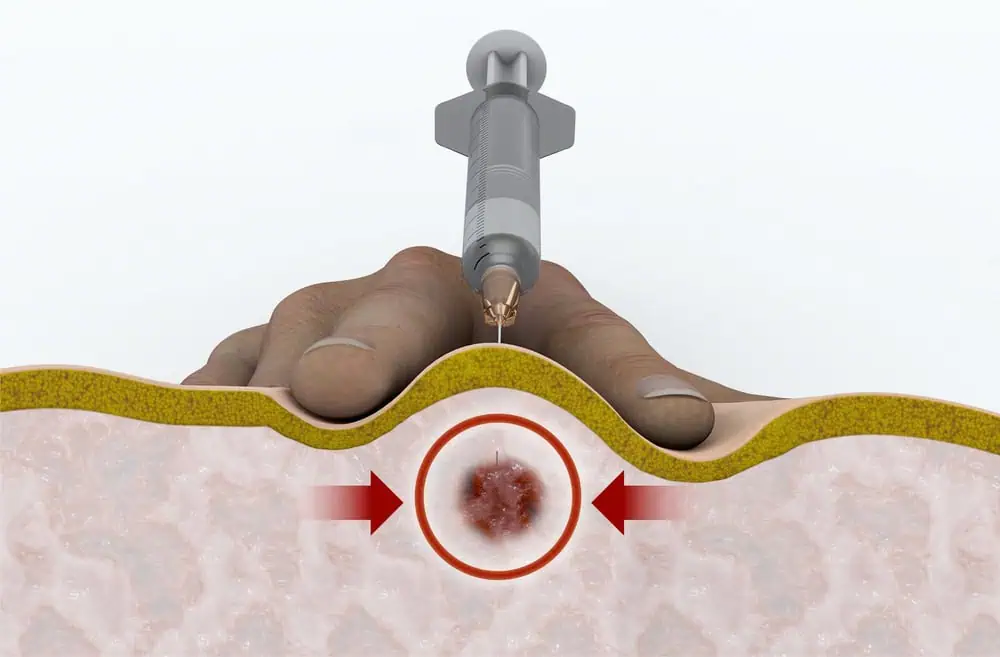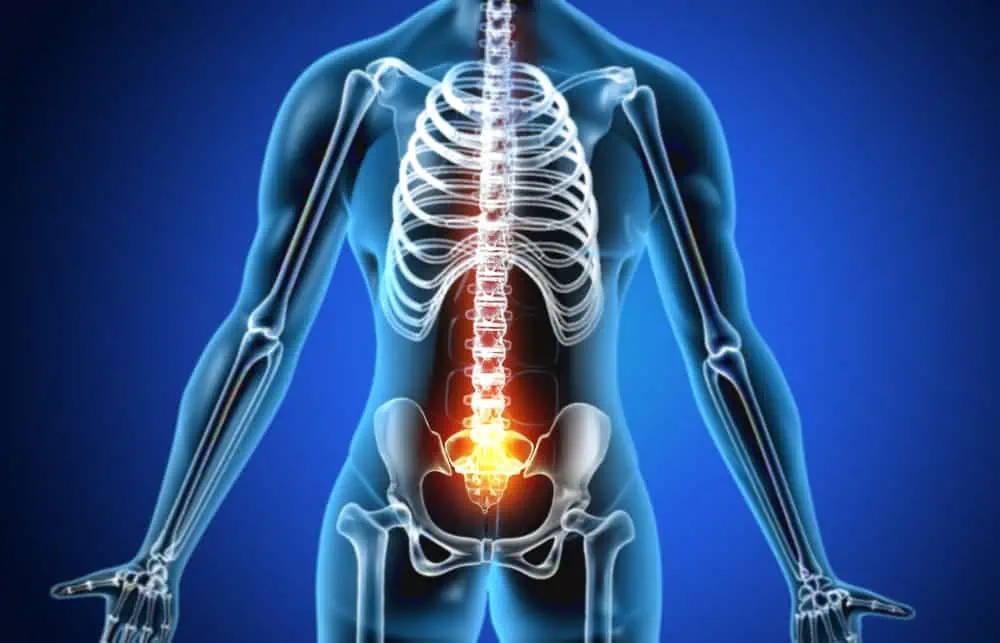Trigger point injections are a treatment used to alleviate myofascial pain, which is a common type of chronic pain that affects muscles and surrounding connective tissue. The procedure specifically targets trigger points, which are sensitive “knots” within the muscles that can cause pain over a large area. These injections are typically considered when other forms of pain management, such as medication or physical therapy, have not been successful.

The process involves a healthcare professional inserting a small needle into the trigger point and delivering a local anesthetic, usually with or without a corticosteroid. This treatment aims to inactivate the trigger points, thereby providing pain relief. It is a minimally invasive procedure and can be an effective part of a multimodal approach to pain management. The types of medications used, as well as the specific techniques, can vary depending on the individual’s needs and the healthcare provider’s experience.
Key Takeaways
- Trigger point injections target painful knots in muscles to alleviate myofascial pain.
- The procedure can include anesthetics or corticosteroids and is delivered directly into the trigger points.
- Trigger point injections are considered when other pain management strategies do not provide sufficient relief.
Understanding Trigger Points
Before we explore the specifics of trigger points, it’s crucial to understand they are not just ordinary muscle aches; they represent specific areas within the muscle that cause significant discomfort and are linked with the distinctive phenomenon of myofascial pain syndrome.
Definition and Characteristics
Trigger points, often referred to as muscle knots, are hyperirritable spots found within the skeletal muscle. These points exhibit unique features such as tenderness, a palpable nodule in the muscles, and a characteristic local twitch response when stimulated. Myofascial trigger points can generate patterns of referred pain away from the site, complicating the process of diagnosis and treatment.
- Tenderness: A hallmark sign of a trigger point, often elicited by palpation.
- Palpable Nodule: The physical manifestation of a trigger point, which can feel like a tight band or knot in the muscle.
- Local Twitch Response: A brief contraction of muscle fibers in response to simulation.
- Referred Pain: Pain that is felt in an area distant from the trigger point location.
Causes of Trigger Point Formation
Our muscles may develop trigger points due to stress, acute trauma, or prolonged muscle tension. Chronic muscle pain associated with conditions like myofascial pain syndrome often has its roots in the development of these points. Here, we’ll discuss two primary reasons they form:
- Acute Trauma: Sudden injuries to the muscle can lead to the development of trigger points.
- Stress on Muscle Fibers: Repeated microtrauma or continuous strain can lead to these areas becoming chronically contracted and sensitive.
- Acute Trauma: A single event causing muscle damage.
- Repetitive Microtrauma: Small, repetitive injuries leading to stress on muscles.
- Chronic Muscle Pain: Ongoing discomfort linked with trigger point activity.
Understanding the nature of trigger points and their common causes lays the groundwork for further discussion on therapeutic interventions, such as trigger point injections, which aim to alleviate the discomfort they cause.
Indications for Trigger Point Injections
We recognize trigger point injections as a precise treatment for managing various pain conditions. Through our experience, we’ve identified certain conditions and symptoms that often indicate the need for this therapy.

Conditions Treated
- Myofascial Pain Syndrome: This condition is often the primary reason we administer trigger point injections, as they are particularly effective for myofascial pain, characterized by sensitive knots in the muscles.
- Chronic Pain: For ongoing pain that does not respond well to other treatments, trigger point injections can provide substantial pain relief.
- Tension Headache: When headaches arise from muscle tension, these injections can often help.
- Fibromyalgia: Although distinct from myofascial pain syndrome, patients with fibromyalgia may also benefit from trigger point injections, particularly for localized pain.
- Neck and Back Pain: These areas are common sites for trigger points, and injections here can relieve pain and improve mobility.
- Joint Pain: When joint pain is associated with tense muscles and trigger points, these injections can be helpful.
Symptoms Addressed
- Pain and Headaches: We can often alleviate pain and tension headaches through the targeted use of trigger point injections.
- Referred Pain: These injections are effective for addressing referred pain, which occurs when a trigger point in one muscle leads to discomfort in another area.
- Decreased Range of Motion and Stiffness: By relieving the muscle tension and knots, we often see an improvement in range of motion and a reduction in stiffness after treatment.
Our approach to trigger point injections is to provide symptom-specific relief for conditions where muscle pain and dysfunction persist. We use these injections to address direct pain points as well as associated symptoms like headaches and joint stiffness, emphasizing the need for an accurate diagnosis and targeted treatment.
Trigger Point Injection Procedure

In this section, we will discuss the specifics of the Trigger Point Injection procedure, including the initial considerations, exact techniques used by healthcare professionals, and essential care following the injection to ensure the best outcomes for pain relief and muscle function.
Pre-Injection Considerations
Before we proceed with a trigger point injection, it is crucial to have a proper diagnosis of myofascial pain syndrome by a healthcare professional. We need to identify the exact muscle groups where the trigger points are located. This might involve physical examination or imaging techniques like ultrasound. It is also imperative to discuss any medications or health conditions that might affect the procedure.
Contraindications such as allergies to anesthetic or steroid medications and current infections must be ruled out. We must consider the patient’s history with other treatments such as physical therapy, exercise, or stretching, as these may influence the approach to the injection.
Injection Technique
The injection itself involves several precise steps. We cleanse the skin over the trigger point to prevent infection. Using a small needle, we inject a solution that typically includes a local anesthetic and may include a steroid.
| Step | Description |
|---|---|
| Needle selection | Choose a small-gauge needle suitable for the depth of the muscle involved. |
| Site preparation | Cleanse the area with antiseptic to minimize infection risk. |
| Injection | Insert the needle into the trigger point, often using a fanning technique to spread the medication throughout the trigger point. |
| Medication administration | Inject a mixture of anesthetic and steroid, or in some cases, perform dry needling without injecting a substance. |
The goal of this technique is to inactivate the trigger point, provide pain relief, and restore the muscle’s full range of motion. We aim to minimize discomfort by using the smallest needle possible and injecting slowly.
Post-Injection Care
After the injection, it’s essential for us to inform our patients about the appropriate care. Typically, there might be immediate pain relief, and we advise patients to keep the muscle active but to avoid strenuous activity for a few days. We recommend simple exercises or stretching to help maintain the muscle’s range of motion and prevent the formation of new trigger points.
| Post-Injection Care | Recommendations |
|---|---|
| Activity | Gentle movement and stretching, avoiding overexertion. |
| Follow-up | Continued physical therapy may be beneficial. |
| Monitor | Keep an eye out for any signs of infection or adverse reactions. |
It is important to follow up with a healthcare professional to evaluate the effectiveness of the injection and decide on any further treatment or continuation of physical therapy.
Types of Medications Used
In administering trigger point injections, we utilize specific medications aimed at alleviating pain associated with myofascial trigger points. The choice of medication depends on the individual case and the desired outcome.
Local Anesthetics
Local anesthetics, like lidocaine and bupivacaine, are commonly used in trigger point injections. We select these medications for their rapid numbing effect, which provides swift pain relief. Patients with an allergy may require alternative medications.
- Lidocaine: Offers quick pain relief, typically with minimal side effects.
- Bupivacaine: Similar to lidocaine but with a longer duration of action.
Corticosteroids
Corticosteroids are anti-inflammatory medications that can be used when prolonged relief from inflammation and pain is necessary. When we combine steroids like corticosteroid with local anesthetics, patients often experience extended relief compared to anesthetics alone.
- Corticosteroid: Helps reduce inflammation and can provide lasting pain relief when used correctly.
Botulinum Toxin and Alternatives
Botulinum toxin, commonly known by the brand name Botox, may be chosen to deactivate trigger points, especially in chronic conditions. When steroids and local anesthetics are not suitable, or if a patient has not responded to these treatments, we might consider botulinum toxin as a potent alternative.
- Botulinum Toxin (Botox): Can provide long-term pain relief, with the effect typically lasting for several months.
Occasionally, we use other alternatives such as saline or ethyl chloride, which can disrupt the trigger point without the use of a traditional medication. This is especially relevant for patients seeking a non-drug approach or those with sensitivities to conventional medications.
Potential Complications and Side Effects
In our practice, we understand that trigger point injections can be an effective treatment for managing muscular pain. Yet, it is essential for us to inform our patients about the potential side effects and risks that may arise from this procedure.

Common Side Effects
During and after trigger point injections, some common side effects could occur. We categorize these as:
- Discomfort or Tenderness at the injection site, which typically subsides quickly.
- Bruising, which is generally minor and resolves on its own.
- Temporary Numbness, sometimes experienced around the injection site due to the anesthetic.
- Instances of Dizziness or Fatigue, which are usually short-lived.
Risks and Complications
While trigger point injections are largely safe, we must be vigilant about more serious risks and complications:
- Bleeding: Rare, yet it can occur, especially if there’s an underlying bleeding disorder.
- Infection, although it is infrequent with proper aseptic technique.
- Allergic Reaction to the medication used, which we screen for prior to treatment.
- In very rare cases, symptoms like Tinnitus may emerge post-procedure, indicating a need for immediate follow-up.
By informing our patients about these potential outcomes, we aim to maximize the benefits of trigger point injections while minimizing any adverse effects.
Efficacy and Outcomes

We’ll explore the success rates and long-term benefits of trigger point injections (TPIs) in the management of chronic muscle pain, specifically referring to their effectiveness in reducing pain and improving quality of life.
Success Rates
Trigger point injections are an established treatment option for providing pain relief in conditions such as myofascial pain syndrome. The success of TPIs largely depends on the accurate identification and treatment of trigger points, which are the focal areas of muscle spasm and inflammation. Studies demonstrate that TPIs can effectively inactivate trigger points, leading to a reduction in pain levels. For example, patients with chronic neck and lower back pain have reported short-term pain relief following TPI treatment, which can last from a few days up to several weeks.
- Myofascial pain: Significant reduction in pain reported post-treatment.
- Neck pain: Patients often experience relief from discomfort and improved mobility.
- Lower back pain: Many report a decrease in the intensity and frequency of pain episodes.
Refer to NCBI Bookshelf for further details on the effectiveness of TPI in inactivating trigger points.
Long-Term Benefits
While trigger point injections are effective for short-term pain relief, we assess their long-term benefits by monitoring improvements in a patient’s quality of life and ability to engage in daily activities. TPIs, as part of a comprehensive pain management plan, can improve functionality and promote a more active lifestyle for individuals suffering from chronic pain conditions like myofascial pain and chronic muscle pain. Ongoing research suggests that repeated TPIs could contribute to sustained muscle relaxation and pain relief.
- Chronic Pain: Patients may report sustained pain relief with regular treatments.
- Quality of Life: Improvements in daily functioning and reductions in pain contribute to a better quality of life.
- Pain Management: Integration into a broader pain management strategy can foster long-term benefits.
An article from Springer provides insights into the systematic review of TPI effectiveness.
Patient Considerations

Before undergoing trigger point injections for myofascial pain, it’s crucial for us to understand the best practices for patient selection and the necessary aftercare to maximize the procedure’s benefits. Proper assessment and follow-up care can significantly influence the treatment’s success.
Patient Selection
When we encounter individuals experiencing persistent myofascial pain that does not respond adequately to conservative treatments like physical therapy or massage, trigger point injections may be a suitable option. We assess the suitability of patients for this treatment by:
- Confirming the diagnosis of myofascial pain syndrome with a healthcare professional.
- Evaluating the musculoskeletal system to identify active trigger points.
- Considering the overall health to ensure they are ideal candidates for the procedure.
Trigger point injections could be more effective when combined with an ongoing physical therapy program. We advise patients to have realistic expectations regarding the outcomes of the treatment and explain the potential for temporary discomfort post-injection.
Aftercare and Follow-Up
After administering trigger point injections, we emphasize the importance of aftercare to facilitate recovery and improve the treatment’s efficacy:
- Patients should perform gentle exercises and myofascial release techniques to maintain muscle flexibility and prevent stiffness.
- Healthcare professionals may prescribe a tailored physical therapy regimen to address any underlying musculoskeletal imbalances.
- Encouraging good sleep hygiene as adequate rest can be beneficial for the healing process.
A follow-up appointment is critical to assess the treatment’s impact on symptoms and to discuss further therapeutic strategies. This might include additional trigger point injections, adjustment of physical therapy activities, or considering other interventions such as massage therapy for ongoing symptom management.
Alternative Treatments

When we consider the management of myofascial pain syndrome, it’s important to also explore treatments aside from trigger point injections. These alternatives can play a crucial role in the holistic care of the condition, focusing on relieving muscle tension, reducing pain, and improving function across affected muscle groups. Let’s look into some of these options in detail.
Physical Manipulations
Physical therapy and myofascial release techniques are critical components in the management of myofascial pain. Engaging in therapies focused on muscle groups afflicted by trigger points can alleviate pain and restore range of motion. Techniques like massage further complement this treatment by promoting relaxation and tension release in the muscles.
Exercise and Stretching
Incorporating exercise and stretching into daily routines can significantly improve the symptoms of myofascial pain. Stretching exercises specifically designed to target affected muscles can help in maintaining and enhancing their flexibility and function. Approaches, such as yoga and Pilates, emphasize the importance of the body’s overall range of motion, contributing to both pain relief and muscle health.
Pharmacological Options
Regarding medication, a variety of pharmacological options exist. These can include:
- Anti-inflammatory medications: Useful for reducing inflammation and providing pain relief.
- Pain medication: Including over-the-counter options like acetaminophen or NSAIDs.
- Muscle relaxants: Sometimes prescribed to lessen muscle tension and spasms.
We advise patients to discuss these medications with healthcare providers to determine the best pharmacological treatment for their specific needs, as they come with differing benefits and potential risks.
Frequently Asked Questions
In this section, we address some of the most common inquiries concerning trigger point injections to provide clarity and peace of mind for those considering this procedure.
What steroid is commonly used for trigger point injections?
The steroids used for trigger point injections typically include corticosteroids such as methylprednisolone or triamcinolone. These steroids are selected for their effectiveness in reducing inflammation and providing pain relief in the muscle.
What are the potential side effects of trigger point injections?
Common side effects of trigger point injections may include pain at the injection site, bruising, and bleeding. Rarely, there may be complications such as infection or nerve damage. Understanding potential side effects is crucial for informed consent.
What can patients expect after receiving trigger point injections?
Post-injection, patients might experience immediate pain relief, though this can vary. Some might have temporary soreness or numbness around the injection site. Patients’ post-procedure experiences are useful to gauge typical outcomes.
How much do trigger point injections typically cost?
The cost of trigger point injections can vary widely based on location, provider, and insurance coverage. Without insurance, they may range from $25 to several hundred dollars per injection.
How frequently can someone receive trigger point injections within a year?
The frequency of trigger point injections varies per individual needs, but typically they can be administered every few months. Physicians typically recommend spacing out injections to avoid potential side effects and assess the effectiveness of treatment over time.
Are trigger point injections widely considered to be effective?
Many healthcare providers consider trigger point injections effective for providing pain relief, especially for conditions like myofascial pain syndrome. Effectiveness, however, can depend on the specific condition being treated and the individual’s response to therapy.











